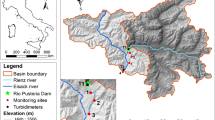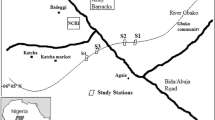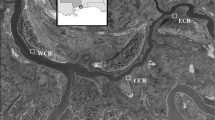Abstract
Macroinvertebrates were examined on an impounded valley marsh in Stonington, Connecticut, that has changed from aTypha-dominated system to one with typical salt-marsh vegetation during 13 years following the reintroduction of tidal exchange. Animal populations on this restored impounded marsh were evaluated by comparing them with populations on a nearby unimpounded valley marsh of roughly the same size. Populations of the high marsh snail,Melampus bidentatus Say, were quantitatively sampled along transects that extended from the water-marsh edge to the upland; those of the ribbed mussel,Geukensia demissa Dillwyn, were sampled in low marsh areas on transects along the banks of creeks and mosquito ditches. The occurrence of other marsh invertebrates also was documented, but their abundance was not measured. The mean density ofMelampus was 332±39.6 SE/m2 on the restored impounded marsh and 712±56.0 SE/m2 on the unimpounded marsh. However, since snails were larger on the restored impounded marsh, the difference in snail biomass was less pronounced than the difference in snail density. MeanMelampus biomass was 4.96±0.52 SE g dry wt/m2 on the restored impounded marsh and 6.96±0.52 SE g dry wt/m2 on the unimpounded marsh. On the two marshes, snail density and biomass varied in relation to plant cover and other factors. The density and biomass ofGeukensia at the edge of the marsh were comparable on the restored impounded and unimpounded marshes. Mean mussel densities ranged from 80 to 240/m2 and mean mussel biomass varied from 24.8–64.8 g dry wt/m2 in different low marsh areas. In contrast, below the impoundment dike, meanGeukensia density was 1100±96.4 SE/m2 and meanGeukensia biomass was 303.6±33.28 SE g dry wt/m2. A consideration of all available evidence leads to the conclusion that the impounded marsh is in an advanced phase of restoration.
Similar content being viewed by others
Literature Cited
Bertness, M. D. 1984. Ribbed mussels andSpartina alterniflora production in a New England salt marsh.Ecology 65:1794–1807.
Bertness, M. D. 1985. Fiddler crab regulation ofSpartina alterniflora production on a New England salt marsh.Ecology 66:1042–1055.
Bertness, M. D., and E. Grosholz. 1985. Population dynamics of the ribbed mussel,Guikensia demissa: The costs and benefits of an aggregated distribution.Oecologia 67:192–204.
Borrero, F. J. 1987. Tidal height and gametogenesis: Reproductive variation among populations ofGeukensia demissa.Biological Bulletin Woods Hole 173:160–168.
Daiber, F. C. 1982. Animals of the tidal marsh. Van Nostrand Reinhold Company, New York, 422 pp.
Erwin, K. L. 1990. Wetland evaluation for restoration and creation. Pages 429–499in J. A. Kusler and M. E. Kentula (eds.), Wetland creation and restoration: The status of the science. Island Press, Washington, DC.
Fell, P. E., and J. H. Williams. 1985. Distribution of the snail,Melampus bidentatus, and the mussel,Geukensia demissa, along the Pataguanset Estuary (Connecticut) in relation to salinity and other tidal marsh invertebrates.The Nautilus 99:21–28.
Fell, P. E., N. C. Olmstead, E. Carlson, W. Jacob, D. Hitchcock, and G. Silber. 1982. Distribution and abundance of marcoinvertebrates on certain Connecticut tidal marshes, with emphasis on dominant molluscs.Estuaries 5:234–239.
Fell, P. E., K. A. Murphy, M. A. Peck, and M. L. Recchia. 1991. Reestablishment ofMelampus bidentatus (Say) and other macroinvertebrates on a restored impounded tidal marsh: Comparison of populations above and below the impoundment dike.Journal of Experimental Marine Biology and Ecology 152:33–48.
Hausman, S. A. 1932. A contribution to the ecology of the salt marsh snail,Melampus bidentatus Say.The American Naturalist 66:541–545.
Hilbish, T. J. 1981. Latitudinal variation in freezing tolerance ofMelampus bidentatus (Say) (Gastropoda: Pulmonata).Journal of Experimental Marine Biology and Ecology 52:283–297.
Holle, P. A., and C. F. Dineen. 1957. Life history of the salt-marsh snail,Melampus bidentatus Say.The Nautilus 70:90–95.
Joyce, A. A., and S. B. Weisberg. 1986. The effects of predation by the mummichog,Fundulus heteroclitus (L.), on the abundance and distribution of the salt marsh snail,Melampus bidentatus (Say).Journal of Experimental Marine Biology and Ecology 100:295–306.
Kraus, M. L., and J. H. Crow. 1985. Substrate characteristics associated with the distribution of the ribbed mussel,Geukensia demissa (Modiolus demissus), on a tidal creek bank in southern New Jersey.Estuaries 8:237–243.
Kuenzler, E. J. 1961. Structure and energy flow of a mussel population in a Georgia salt marsh.Limnology and Oceanography. 6:191–204.
Lent, C. M. 1969. Adaptation of the ribbed mussel,Modiolus demissus (Dillwyn), to the intertidal habitat.American Zoologist 9:283–292.
Lin, J. 1989a. Influence of location on a salt marsh on survivorship of ribbed mussels.Marine Ecology Progress Series 56:105–110.
Lin, J. 1989b. Importance of location in the salt marsh and clump size on growth of ribbed mussels.Journal of Experimental Marine Biology and Ecology 128:75–86.
Luckenbach, M. W., R. J. Diaz, E. C. Zobrist, and C. H. Hutton. 1990. Evaluation of the benthic resource value of impounded and nonimpounded tidal creeks in Virginia, USA.Ocean and Shoreline Management. 14:35–50.
McMahon, R. F., and W. D. Russell-Hunter. 1981. The effects of physical variables and acclimation on survival and oxygen consumption in the high littoral salt-marsh snail,Melampus bidentatus Say.Biological Bulletin Woods Hole 161:246–269.
Miller, K. G., and D. Maurer. 1973. Distribution of the fiddler crabs,Uca pugnax andUca minax, in relation to salinity in Delaware rivers.Chesapeake Science 14:219–221.
Parker, N. H. 1976. The distribution, growth and life history ofMelampus bidentatus (Gastropoda: Pulmonata) in the Delaware Bay region. Master's thesis. University of Delaware, Newark, Delaware, 65 pp.
Price, C. H. 1980. Water relations and physiological ecology of the salt marsh snail,Melampus bidentatus Say.Journal of Experimental Marine Biology and Ecology 45:51–68.
Rietsma, C. S., I. Valiela, and A. Sylvester-Serianni. 1982. Food preferences of dominant salt marsh herbivores and detritivores.Marine Ecology 3:179–189.
Rietsma, C. S., I. Valiela, and R. Buchsbaum. 1988. Detrital chemistry, growth, and food choice in the salt-marsh snail (Melampus bidentatus).Ecology 69:261–266.
Ringold, P. 1979. Burrowing, root mat density, and the distribution of fiddler crabs in the eastern United States.Journal of Experimental Marine Biology and Ecology 36:11–21.
Rodriguez-Ortéga, D., and J. W. Day. 1978. An ecological study ofModiolus demissus granossissimus Sowerby in Louisiana (USA).Anales del Centro de Ciencias del Mar y Limnologia, Universidad Nacional Autonoma de Mexico. 5:215–224.
Russell-Hunter, W. D., M. L. Apley, and R. D. Hunter. 1972. Early lfe history ofMelampus and the significance of semilunar synchrony. Biological Bulletin Woods Hole 143:623–656.
Shisler, J. K. 1990. Creation and restoration of coastal wetlands of the northeastern United States. Pages 143–163in J. A. Kusler and M. E. Kentula (eds.), Wetland creation and restoration: The status of the science. Island Press, Washington, DC.
Sinicrope, T. L., P. G. Hine, R. S. Warren, and W. A. Niering. 1990. Restoration of an impounded salt marsh in New England.Estuaries 13:25–30.
SPSS-X, 1986. User's guide, McGraw-Hill, New York, 988 pp.
Teal, J. M. 1958. Distribution of fiddler crabs in Georgia salt marshes.Ecology 39:185–193.
Vince, S., I. Valiela, N. Backus, and J. M. Teal. 1976. Predation by the salt marsh killifishFundulus heteroclitus (L.) in relation to prey size and habitat structure: Consequences for prey distribution and abundance.Journal of Experimental Marine Biology and Ecology 23:255–266.
Warren, R. S., P. E. Fell, and W. A. Niering. 1993. Biotic changes at the Barn Island Tidal Marshes (Stonington, CT): Sea-level rise and restoration. Long Island Sound Conference Proceedings. Connecticut Sea Grant Publications (in press).
Zar, J. H. 1984. Biostatistical analysis. Prentice-Hall, Englewood Cliffs, New Jersey, 718 pp.
Author information
Authors and Affiliations
Rights and permissions
About this article
Cite this article
Peck, M.A., Fell, P.E., Allen, E.A. et al. Evaluation of tidal marsh restoration: Comparison of selected macroinvertebrate populations on a restored impounded valley marsh and an unimpounded valley marsh within the same salt marsh system in Connecticut, USA. Environmental Management 18, 283–293 (1994). https://doi.org/10.1007/BF02393769
Issue Date:
DOI: https://doi.org/10.1007/BF02393769




